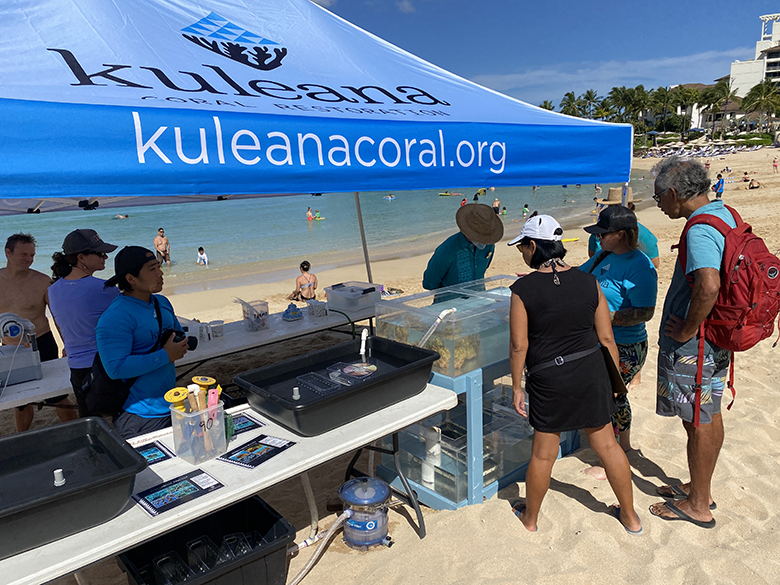- ABOUT US
- PROGRAM AREAS
- CONSERVATION APPROACH
- EDUCATION
- MULTIMEDIA
Fishermen, surfers, and scientists unite to restore degraded reefs in Hawai'i
By: Carissa Cabrera and Blake Nowack, Kuleana Coral Restoration
Takeaway
With the continued stress to coral reef survival, coral restoration efforts in Hawai'i are needed to protect coastlines, fisheries, and the communities that rely on them. Kuleana Coral Restoration is scaling up a cost-effective, localized approach to restoration that allows citizen scientists to participate in the process.
Background
Similar to reefs around the world, the coral reefs of Hawai'i are being degraded and lost due to human impacts. This degradation decreases reef biodiversity, fisheries, and overall ecosystem health. On O'ahu in particular, reef health directly impacts economic livelihoods, through fisheries, biodiversity, tourism, and coastal protection. However, open ocean swells and an active fishing sector means restoration techniques must be tailored to the unique environment there. As a result, Kuleana Coral Restoration (KCR) was founded by fishers, surfers, and scientists to pair traditional knowledge with scientific techniques to restore West O'ahu reefs and cultivate reef resilience. This place-based approach is scalable, cost-effective, and allows the public to join in.


While KCR's dive team is surveying a site, they identify corals that have been dislodged from the reef and would otherwise die without intervention. We call these Corals of Opportunity, and they can be collected and reattached to the reef as a cost-effective restoration approach. These Large Rescue Colonies (LRCs) can represent up to 50 years of coral growth and reattaching them to substrate immediately returns ecological services to the reef. Since Hawai'i is home to mostly slow-growth corals, this approach significantly impacts restoration, while being straight-forward and replicable in other communities.
For Corals of Opportunity (COOs) that are smaller in size and therefore younger, they are collected and stored in seawater. By keeping the corals in seawater, KCR avoids the costs of a land-based nursery while still maximizing restoration impact. These COOs are used for fragmentation with the public, students, or KCR team. Fragmentation is a demonstrated technique that cuts corals into smaller pieces to stimulate rapid growth. The fragments are attached to a substrate and outplanted onto the reef at a restoration site. Because fragments from the same colony are used, they fuse together as they grow, forming one colony in a fraction of the time it would take them to grow otherwise.
The nature of KCR's fragmentation events allows local community members and visitors to learn about coral through hands-on restoration, while also gaining insight for scalable and effective restoration methods. Throughout the outreach process, KCR is able to educate the public on what coral restoration looks like in West O'ahu, based on our coastal environment, coral species, and fish populations.

Since 2019, KCR has prioritized restoration techniques that can be scaled quickly and led by local communities interested in stewarding their own coastal coral reefs. With the help of many citizen scientists, weʻve outplanted 1,500+ corals to sites across West Oʻahu and beyond. Looking ahead, we aim to build training infrastructure for local communities so they can participate in restoring corals and monitoring the long-term recovery of their resources. In spring 2023, KCR received funding from the Bipartisan Infrastructure Law under the Coastal Habitat Restoration and Resilience Grants for Underserved Communities to engage community members on West O’ahu in coral reef conservation and reduce barriers to environmental work for Native Hawaiians. Kuleana Coral Restoration will train early career residents in coral conservation, ecology, restoration, and scientific techniques starting in summer 2023.
About Us

The NOAA Coral Reef Conservation Program was established in 2000 by the Coral Reef Conservation Act. Headquartered in Silver Spring, Maryland, the program is part of NOAA's Office for Coastal Management.

The Coral Reef Information System (CoRIS) is the program's information portal that provides access to NOAA coral reef data and products.
Work With US
U.S. Coral Reef Task Force
Funding Opportunities
Employment
Fellowship Program
Contracting Assistance
Graphic Identifier
Featured Stories Archive

Access the archive of featured stories here...
Feedback
Thank you for visiting NOAA’s Coral Reef Conservation Program online. Please take our website satisfaction survey. We welcome your ideas, comments, and feedback. Questions? Email coralreef@noaa.gov.
Stay Connected
Contact Us
NOAA’s Coral Reef Conservation Program
SSMC4, 10th Floor
1305 East West Highway
Silver Spring, MD 20910
coralreef@noaa.gov
